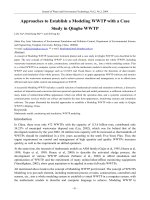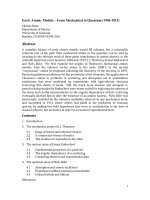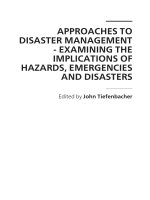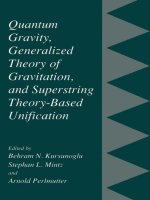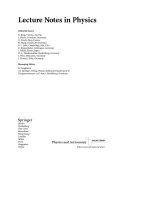- Trang chủ >>
- Khoa Học Tự Nhiên >>
- Vật lý
Approaches to Quantum Gravity
Bạn đang xem bản rút gọn của tài liệu. Xem và tải ngay bản đầy đủ của tài liệu tại đây (4.36 MB, 605 trang )
Approachesto
Quantum Gravi
ty
By
Dani
eleOri
ti
This page intentionally left blank
www.pdfgrip.com
APPROACHES TO QUANTUM GRAVITY
Toward a New Understanding of Space, Time and Matter
The theory of quantum gravity promises a revolutionary new understanding
of gravity and spacetime, valid from microscopic to cosmological distances.
Research in this field involves an exciting blend of rigorous mathematics and bold
speculations, foundational questions and technical issues.
Containing contributions from leading researchers in this field, this book
presents the fundamental issues involved in the construction of a quantum theory of
gravity and building up a quantum picture of space and time. It introduces the most
current approaches to this problem, and reviews their main achievements. Each
part ends in questions and answers, in which the contributors explore the merits
and problems of the various approaches. This book provides a complete overview
of this field from the frontiers of theoretical physics research for graduate students
and researchers.
D A N I E L E O R I T I is a Researcher at the Max Planck Institute for Gravitational
Physics, Potsdam, Germany, working on non-perturbative quantum gravity. He
has previously worked at the Perimeter Institute for Theoretical Physics, Canada;
the Institute for Theoretical Physics at Utrecht University, The Netherlands; and
the Department of Applied Mathematics and Theoretical Physics, University of
Cambridge, UK. He is well known for his results on spin foam models, and is
among the leading researchers in the group field theory approach to quantum
gravity.
www.pdfgrip.com
www.pdfgrip.com
APPROACHES TO QUANTUM GRAVITY
Toward a New Understanding of Space,
Time and Matter
Edited by
DANIELE ORITI
Max Planck Institute for Gravitational Physics,
Potsdam, Germany
www.pdfgrip.com
CAMBRIDGE UNIVERSITY PRESS
Cambridge, New York, Melbourne, Madrid, Cape Town, Singapore, São Paulo
Cambridge University Press
The Edinburgh Building, Cambridge CB2 8RU, UK
Published in the United States of America by Cambridge University Press, New York
www.cambridge.org
Information on this title: www.cambridge.org/9780521860451
© Cambridge University Press 2009
This publication is in copyright. Subject to statutory exception and to the
provision of relevant collective licensing agreements, no reproduction of any part
may take place without the written permission of Cambridge University Press.
First published in print format 2009
ISBN-13
978-0-511-51640-5
eBook (EBL)
ISBN-13
978-0-521-86045-1
hardback
Cambridge University Press has no responsibility for the persistence or accuracy
of urls for external or third-party internet websites referred to in this publication,
and does not guarantee that any content on such websites is, or will remain,
accurate or appropriate.
www.pdfgrip.com
A Sandra
www.pdfgrip.com
www.pdfgrip.com
Contents
List of contributors
Preface
page x
xv
Part I Fundamental ideas and general formalisms
1 Unfinished revolution
C. Rovelli
2 The fundamental nature of space and time
G. ’t Hooft
3 Does locality fail at intermediate length scales?
R. D. Sorkin
4 Prolegomena to any future Quantum Gravity
J. Stachel
5 Spacetime symmetries in histories canonical gravity
N. Savvidou
6 Categorical geometry and the mathematical
foundations of Quantum Gravity
L. Crane
7 Emergent relativity
O. Dreyer
8 Asymptotic safety
R. Percacci
9 New directions in background independent Quantum Gravity
F. Markopoulou
Questions and answers
Part II String/M-theory
10 Gauge/gravity duality
G. Horowitz and J. Polchinski
1
3
13
26
44
68
84
99
111
129
150
167
169
vii
www.pdfgrip.com
viii
Contents
11 String theory, holography and Quantum Gravity
T. Banks
12 String field theory
W. Taylor
Questions and answers
Part III Loop quantum gravity and spin foam models
13 Loop quantum gravity
T. Thiemann
14 Covariant loop quantum gravity?
E. Livine
15 The spin foam representation of loop quantum gravity
A. Perez
16 Three-dimensional spin foam Quantum Gravity
L. Freidel
17 The group field theory approach to Quantum Gravity
D. Oriti
Questions and answers
Part IV Discrete Quantum Gravity
18 Quantum Gravity: the art of building spacetime
J. Ambjørn, J. Jurkiewicz and R. Loll
19 Quantum Regge calculus
R. Williams
20 Consistent discretizations as a road to Quantum Gravity
R. Gambini and J. Pullin
21 The causal set approach to Quantum Gravity
J. Henson
Questions and answers
Part V Effective models and Quantum Gravity phenomenology
22 Quantum Gravity phenomenology
G. Amelino-Camelia
23 Quantum Gravity and precision tests
C. Burgess
24 Algebraic approach to Quantum Gravity II: noncommutative
spacetime
S. Majid
www.pdfgrip.com
187
210
229
233
235
253
272
290
310
332
339
341
360
378
393
414
425
427
450
466
Contents
ix
25 Doubly special relativity
J. Kowalski-Glikman
26 From quantum reference frames to deformed special relativity
F. Girelli
27 Lorentz invariance violation and its role in Quantum Gravity
phenomenology
J. Collins, A. Perez and D. Sudarsky
28 Generic predictions of quantum theories of gravity
L. Smolin
Questions and answers
493
Index
580
www.pdfgrip.com
509
528
548
571
Contributors
J. Ambjørn
The Niels Bohr Institute, Copenhagen University, Blegdamsvej 17, DK-2100
Copenhagen O, Denmark
and
Institute for Theoretical Physics, Utrecht University, Leuvenlaan 4,
NL-3584 CE Utrecht, The Netherlands
G. Amelino-Camelia
Dipartimento di Fisica, Universitá di Roma “La Sapienza”, P.le A. Moro 2,
00185 Rome, Italy
T. Banks
Department of Physics, University of California, Santa Cruz, CA 95064, USA
and
NHETC, Rutgers University, Piscataway, NJ 08854, USA
C. Burgess
Department of Physics & Astronomy, McMaster University, 1280 Main St. W,
Hamilton, Ontario, Canada, L8S 4M1
and
Perimeter Institute for Theoretical Physics, 31 Caroline St. N, Waterloo N2L
2Y5, Ontario, Canada
J. Collins
Physics Department, Pennsylvania State University, University Park, PA 16802,
USA
L. Crane
Mathematics Department, Kansas State University, 138 Cardwell Hall Manhattan,
KS 66506-2602, USA
x
www.pdfgrip.com
List of contributors
xi
O. Dreyer
Theoretical Physics, Blackett Laboratory, Imperial College London, London, SW7
2AZ, UK
L. Freidel
Perimeter Institute for Theoretical Physics, 31 Caroline St. N, Waterloo N2L 2Y5,
Ontario, Canada
R. Gambini
Instituto de Física, Facultad de Ciencias, Iguá 4225, Montevideo, Uruguay
F. Girelli
SISSA, via Beirut 4, Trieste, 34014, Italy, and INFN, sezione di Trieste, Italy
J. Henson
Institute for Theoretical Physics, Utrecht University, Leuvenlaan 4, NL-3584 CE
Utrecht, The Netherlands
G. Horowitz
Physics Department, University of California, Santa Barbara, CA 93106, USA
J. Jurkiewicz
Institute of Physics, Jagellonian University, Reymonta 4, PL 30-059 Krakow,
Poland
J. Kowalski-Glikman
Institute for Theoretical Physics, University of Wroclaw 50-204 Wroclaw, pl. M.
Borna 9, Poland
E. Livine
Ecole Normale Supérieure de Lyon, 46 Allée d’Italie, 69364 Lyon Cedex 07, France
R. Loll
Institute for Theoretical Physics, Utrecht University, Leuvenlaan 4, NL-3584 CE
Utrecht, The Netherlands
S. Majid
School of Mathematical Sciences, Queen Mary, University of London
327 Mile End Rd, London E1 4NS, UK
and
Perimeter Institute for Theoretical Physics, 31 Caroline St. N., Waterloo ON N2L
2Y5, Canada
F. Markopoulou
Perimeter Institute for Theoretical Physics, 31 Caroline St. N., Waterloo ON N2L
2Y5, Canada
www.pdfgrip.com
xii
List of contributors
D. Oriti
Max Planck Institute for Gravitational Physics, Am Mühlenberg 1, D 14476 Golm,
Germany
R. Percacci
SISSA, via Beirut 4, Trieste, 34014, Italy, and INFN, sezione di Trieste, Italy
A. Perez
Centre de Physique Théorique, Unité Mixte de Recherche (UMR 6207)
du CNRS et des Universités Aix-Marseille I, Aix-Marseille II, et du Sud Toulon-Var,
laboratoire afilié à la FRUMAM (FR 2291), Campus de Luminy, 13288 Marseille,
France
J. Polchinski
Department of Physics, University of California, Santa Barbara CA 93106, USA
J. Pullin
Department of Physics and Astronomy, Louisiana State University, Baton Rouge,
LA 70803 USA
C. Rovelli
Centre de Physique Théorique, Unité Mixte de Recherche (UMR 6207)
du CNRS et des Universités Aix-Marseille I, Aix-Marseille II, et du Sud Toulon-Var,
laboratoire afilié à la FRUMAM (FR 2291), Campus de Luminy, 13288 Marseille,
France
N. Savvidou
Theoretical Physics, Blackett Laboratory, Imperial College London, London SW7
2AZ, UK
L. Smolin
Perimeter Institute for Theoretical Physics, Waterloo N2J 2W9, Ontario, Canada
and
Department of Physics, University of Waterloo, Waterloo N2L 3G1, Ontario,
Canada
R. D. Sorkin
Perimeter Institute for Theoretical Physics, Waterloo N2J 2W9, Ontario, Canada
J. Stachel
CAS Physics, Boston University, 745 Commonwealth Avenue, MA 02215, USA
D. Sudarsky
Instituto de Ciencias Nucleares, Universidad Autónoma de México, A. P. 70-543,
México D.F. 04510, México
www.pdfgrip.com
List of contributors
xiii
W. Taylor
Massachusetts Institute of Technology, Lab for Nuclear Science and Center for
Theoretical Physics, 77 Massachusetts Ave., Cambridge, MA 02139-4307, USA
T. Thiemann
Max-Planck-Institut für Gravitationsphysik, Albert-Einstein-Institut,
Am Mühlenberg 1, D-14476 Golm, Germany
and
Perimeter Institute for Theoretical Physics, 31 Caroline St. North, Waterloo N2L
2Y5, Ontario, Canada
G. ’t Hooft
Institute for Theoretical Physics, Utrecht University, Leuvenlaan 4, NL-3584 CE
Utrecht, The Netherlands
R. Williams
Department of Applied Mathematics and Theoretical Physics, Centre for
Mathematical Sciences, University of Cambridge, Wilberforce Road, Cambridge
CB3 0WA, UK
www.pdfgrip.com
www.pdfgrip.com
Preface
Quantum Gravity is a dream, a theoretical need and a scientific goal. It is a theory
which still does not exist in complete form, but that many people claim to have had
glimpses of, and it is an area of research which, at present, comprises the collective
efforts of hundreds of theoretical and mathematical physicists.
This yet-to-be-found theory promises to be a more comprehensive and complete description of the gravitational interaction, a description that goes beyond
Einstein’s General Relativity in being possibly valid at all scales of distances and
energy; at the same time it promises to provide a new and deeper understanding of
the nature of space, time and matter.
As such, research in Quantum Gravity is a curious and exciting blend of rigorous mathematics and bold speculations, concrete models and general schemata,
foundational questions and technical issues, together with, since recently, tentative
phenomenological scenarios.
In the past three decades we have witnessed an amazing growth of the field of
Quantum Gravity, of the number of people actively working in it, and consequently
of the results achieved. This is due to the fact that some approaches to the problem started succeeding in solving outstanding technical challenges, in suggesting
ways around conceptual issues, and in providing new physical insights and scenarios. A clear example is the explosion of research in string theory, one of the main
candidates to a quantum theory of gravity, and much more. Another is the development of Loop Quantum Gravity, an approach that attracted much attention recently,
due to its successes in dealing with many long standing problems of the canonical
approach to Quantum Gravity. New techniques have been then imported to the field
from other areas of theoretical physics, e.g. Lattice Gauge Theory, and influenced
in several ways the birth or growth of even more directions in Quantum Gravity
research, including for example discrete approaches. At the same time, Quantum
Gravity has been a very fertile ground and a powerful motivation for developing
xv
www.pdfgrip.com
xvi
Preface
new mathematics as well as alternative ways of thinking about spacetime and matter, which in turn have triggered the exploration of other promising avenues toward
a Quantum Gravity theory.
I think it is fair to say that we are still far from having constructed a satisfactory theory of Quantum Gravity, and that any single approach currently being
considered is too incomplete or poorly understood, whatever its strengths and successes may be, to claim to have achieved its goal, or to have proven to be the only
reasonable way to proceed.
On the other hand every single one of the various approaches being pursued has
achieved important results and insights regarding the Quantum Gravity problem.
Moreover, technical or conceptual issues that are unsolved in one approach have
been successfully tackled in another, and often the successes of one approach have
clearly come from looking at how similar difficulties had been solved in another.
It is even possible that, in order to achieve our common goal, formulate a complete theory of Quantum Gravity and unravel the fundamental nature of space and
time, we will have to regard (at least some of) these approaches as different aspects
of the same theory, or to develop a more complete and more general approach that
combines the virtues of several of them. However strong faith one may have in any
of these approaches, and however justified this may be in light of recent results,
it should be expected, purely on historical grounds, that none of the approaches
currently pursued will be understood in the future in the same way as we do now,
even if it proves to be the right way to proceed. Therefore, it is useful to look
for new ideas and a different perspective on each of them, aided by the the insights
provided by the others. In no area of research a “dogmatic approach” is less productive, I feel, than in Quantum Gravity, where the fundamental and complex nature
of the problem, its many facets and long history, combined with a dramatically (but
hopefully temporarily) limited guidance from Nature, suggest a very open-minded
attitude and a very critical and constant re-evaluation of one’s own strategies.
I believe, therefore, that a broad and well-informed perspective on the various present approaches to Quantum Gravity is a necessary tool for advancing
successfully in this area.
This collective volume, benefiting from the contributions of some of the best
Quantum Gravity practitioners, all working at the frontiers of current research, is
meant to represent a good starting point and an up-to-date support reference, for
both students and active researchers in this fascinating field, for developing such a
broader perspective. It presents an overview of some of the many ideas on the table,
an introduction to several current approaches to the construction of a Quantum Theory of Gravity, and brief reviews of their main achievements, as well as of the many
outstanding issues. It does so also with the aim of offering a comparative perspective on the subject, and on the different roads that Quantum Gravity researchers
www.pdfgrip.com
Preface
xvii
are following in their searches. The focus is on non-perturbative aspects of Quantum Gravity and on the fundamental structure of space and time. The variety of
approaches presented is intended to ensure that a variety of ideas and mathematical
techniques will be introduced to the reader.
More specifically, the first part of the book (Part I) introduces the problem of
Quantum Gravity, and raises some of the fundamental questions that research in
Quantum Gravity is trying to address. These concern for example the role of locality and of causality at the most fundamental level, the possibility of the notion of
spacetime itself being emergent, the possible need to question and revise our way
of understanding both General Relativity and Quantum Mechanics, before the two
can be combined and made compatible in a future theory of Quantum Gravity. It
provides as well suggestions for new directions (using the newly available tools of
category theory, or quantum information theory, etc.) to explore both the construction of a quantum theory of gravity, as well as our very thinking about space and
time and matter.
The core of the book (Parts II–IV) is devoted to a presentation of several
approaches that are currently being pursued, have recently achieved important
results, and represent promising directions. Among these the most developed and
most practiced are string/M-theory, by far the one which involves at present the
largest amount of scholars, and loop quantum gravity (including its covariant
version, i.e. spin foam models). Alongside them, we have various (and rather different in both spirit and techniques used) discrete approaches, represented here
by simplicial quantum gravity, in particular the recent direction of causal dynamical triangulations, quantum Regge calculus, and the “consistent discretization
scheme”, and by the causal set approach.
All these approaches are presented at an advanced but not over-technical level,
so that the reader is offered an introduction to the basic ideas characterizing any
given approach as well as an overview of the results it has already achieved and
a perspective on its possible development. This overview will make manifest the
variety of techniques and ideas currently being used in the field, ranging from continuum/analytic to discrete/combinatorial mathematical methods, from canonical
to covariant formalisms, from the most conservative to the most radical conceptual
settings.
The final part of the book (Part V) is devoted instead to effective models of
Quantum Gravity. By this we mean models that are not intended to be of a fundamental nature, but are likely to provide on the one hand key insights on what
sort of features the more fundamental formulation of the theory may possess, and
on the other powerful tools for studying possible phenomenological consequences
of any Quantum Gravity theory, the future hopefully complete version as well
www.pdfgrip.com
xviii
Preface
as the current tentative formulations of it. The subject of Quantum Gravity phenomenology is a new and extremely promising area of current research, and gives
ground to the hope that in the near future Quantum Gravity research may receive
experimental inputs that will complement and direct mathematical insights and
constructions.
The aim is to convey to the reader the recent insight that a Quantum Gravity
theory need not be forever detached by the experimental realm, and that many
possibilities for a Quantum Gravity phenomenology are instead currently open to
investigation.
At the end of each part, there is a “Questions & Answers” session. In each of
them, the various contributors ask and put forward to each other questions, comments and criticisms to each other, which are relevant to the specific topic covered
in that part. The purpose of these Q&A sessions is fourfold: (a) to clarify further
subtle or particularly relevant features of the formalisms or perspectives presented;
(b) to put to the forefront critical aspects of the various approaches, including
potential difficulties or controversial issues; (c) to give the reader a glimpse of the
real-life, ongoing debates among scholars working in Quantum Gravity, of their
different perspectives and of (some of) their points of disagreement; (d) in a sense,
to give a better picture of how science and research (in particular, Quantum Gravity
research) really work and of what they really are.
Of course, just as the book as a whole cannot pretend to represent a complete account of what is currently going on in Quantum Gravity research, these
Q&A sessions cannot really be a comprehensive list of relevant open issues nor a
faithful portrait of the (sometimes rather heated) debate among Quantum Gravity
researchers.
What this volume makes manifest is the above-mentioned impressive development that occurred in the field of Quantum Gravity as a whole, over the past, say,
20–30 years. This is quickly recognized, for example, by comparing the range and
content of the following contributed papers to the content of similar collective volumes, like Quantum Gravity 2: a second Oxford symposium, C. Isham, ed., Oxford
University Press (1982), Quantum structure of space and time, M. Duff, C. Isham,
eds., Cambridge University Press (1982), Quantum Theory of Gravity, essays in
honor of the 60th Birthday of Bryce C DeWitt, S. D. Christensen, ed., Taylor and
Francis (1984), or even the more recent Conceptual problems of Quantum Gravity, A. Ashtekar, J. Stachel, eds., Birkhauser (1991), all presenting overviews of
the status of the subject at their time. Together with the persistence of the Quantum Gravity problem itself, and of the great attention devoted, currently just as
then, to foundational issues alongside the more technical ones, it will be impossible not to notice the greater variety of current approaches, the extent to which
researchers have explored beyond the traditional ones, and, most important, the
www.pdfgrip.com
Preface
xix
enormous amount of progress and achievements in each of them. Moreover, the
very existence of research in Quantum Gravity phenomenology was un-imaginable
at the time.
Quantum Gravity remains, as it was in that period, a rather esoteric subject,
within the landscape of theoretical physics at large, but an active and fascinating
one, and one of fundamental significance. The present volume is indeed a collective
report from the frontiers of theoretical physics research, reporting on the latest and
most exciting developments but also trying to convey to the reader the sense of
intellectual adventure that working at such frontiers implies.
It is my pleasure to thank all those that have made the completion of this project
possible. First of all, I gratefully thank all the researchers who have contributed to
this volume, reporting on their work and on the work of their colleagues in such
an excellent manner. This is a collective volume, and thus, if it has any value, it is
solely due to all of them. Second, I am grateful to all the staff at the Cambridge
University Press, and in particular to Simon Capelin, for supporting this project
since its conception, and for guiding me through its development. Last, I would
like to thank, for very useful comments, suggestions and advice, several colleagues
and friends: John Baez, Fay Dowker, Sean Hartnoll, Chris Isham, Prem Kumar,
Pietro Massignan, and especially Ted Jacobson.
Daniele Oriti
www.pdfgrip.com
www.pdfgrip.com
Part I
Fundamental ideas and general formalisms
www.pdfgrip.com
www.pdfgrip.com
1
Unfinished revolution
C. ROVELLI
One hundred and forty-four years elapsed between the publication of Copernicus’s
De Revolutionibus, which opened the great scientific revolution of the seventeenth
century, and the publication of Newton’s Principia, the final synthesis that brought
that revolution to a spectacularly successful end. During those 144 years, the basic
grammar for understanding the physical world changed and the old picture of
reality was reshaped in depth.
At the beginning of the twentieth century, General Relativity (GR) and Quantum
Mechanics (QM) once again began reshaping our basic understanding of space and
time and, respectively, matter, energy and causality – arguably to a no lesser extent.
But we have not been able to combine these new insights into a novel coherent
synthesis, yet. The twentieth-century scientific revolution opened by GR and QM
is therefore still wide open. We are in the middle of an unfinished scientific revolution. Quantum Gravity is the tentative name we give to the “synthesis to be
found”.
In fact, our present understanding of the physical world at the fundamental level
is in a state of great confusion. The present knowledge of the elementary dynamical laws of physics is given by the application of QM to fields, namely Quantum
Field Theory (QFT), by the particle-physics Standard Model (SM), and by GR.
This set of fundamental theories has obtained an empirical success nearly unique
in the history of science: so far there isn’t any clear evidence of observed phenomena that clearly escape or contradict this set of theories – or a minor modification of
the same, such as a neutrino mass or a cosmological constant.1 But, the theories in
this set are based on badly self-contradictory assumptions. In GR the gravitational
field is assumed to be a classical deterministic dynamical field, identified with the
(pseudo) Riemannian metric of spacetime: but with QM we have understood that
all dynamical fields have quantum properties. The other way around, conventional
1 Dark matter (not dark energy) might perhaps be contrary evidence.
Approaches to Quantum Gravity: Toward a New Understanding of Space, Time and Matter, ed. Daniele Oriti.
Published by Cambridge University Press. c Cambridge University Press 2009.
www.pdfgrip.com
